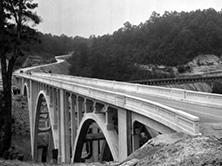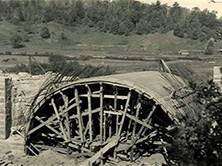 Reinforced concrete High Bridge (Henderson County Bridge 20) carrying the Spartanburg Highway/US 176 over the Green River gorge between East Flat Rock and Saluda, ca.1927 (D.H. Ramsey Library Special Collections, UNC-Asheville)
Reinforced concrete High Bridge (Henderson County Bridge 20) carrying the Spartanburg Highway/US 176 over the Green River gorge between East Flat Rock and Saluda, ca.1927 (D.H. Ramsey Library Special Collections, UNC-Asheville) Most prevalent among the early-20th-century highway bridges in North Carolina are those built with reinforced concrete. As its name suggests, the material is made up of concrete with an embedded metal, such as steel.
It was introduced into the United States for bridge construction in the late 1880s, Americans began to develop an equivalent of Portland cement — an artificial hydraulic cement noted for its strength and abrasion resistance — and the determination, often through trial-and-error, of viable types, shapes, and patterns of reinforcing bars or netting to place in the cement to increase its strength.
Reinforced concrete bridges became increasingly common in North Carolina after 1910. Part of the reason for the material’s acceptance was that reinforced concrete was used for a variety of structure types — buildings, railroad ties, piers, bulkheads — and the knowledge transfer benefitted all.
Additionally, individual promoters such as Daniel B. Luten and companies including the Corrugated Bar Company, which published how-to brochures on reinforced concrete bridges using steel bars, aggressively marketed reinforced concrete as a bridge building material. In the era before the State Highway Commission, such promotional literature did much to spread information about the advantages of reinforced concrete to county and municipal road officials.
 Rusticated Blue Ridge Parkway bridge (likely Allegany County Bridge 13), 1938—note reinforcing bars extended out over either side of wooden formwork in preparation for pouring of concrete arch (National Park Service, Documenting the American South, UNC-Chapel Hill) Reinforced concrete bridges proved to be economical and relatively low-maintenance alternatives to metal-truss spans, but the results were not always what promoters promised.
Rusticated Blue Ridge Parkway bridge (likely Allegany County Bridge 13), 1938—note reinforcing bars extended out over either side of wooden formwork in preparation for pouring of concrete arch (National Park Service, Documenting the American South, UNC-Chapel Hill) Reinforced concrete bridges proved to be economical and relatively low-maintenance alternatives to metal-truss spans, but the results were not always what promoters promised.
Many professional engineering associations, university engineering departments, and government organizations conducted scientific examinations of reinforced concrete during the early 20th century. By the time North Carolina launched its state highway system in the early 1920s, most of the problems with the quality of materials and construction methods had been solved.
The State Highway Commission published standard specifications that governed the quality and use of reinforced concrete and its placement. The specifications were based on, and sometimes even copied, the guidelines developed by the federal government and industry associations, and they further promoted the standardization and uniformity of design that was the Commission’s goal in the development of the state highway system.
Reinforced concrete slabs, T-beams and through girders were the most important reinforced concrete bridges used by the State Highway Commission in its early years. They proved ideally suited to the preparation of standard plans that could be used in a variety of site conditions, with the result that hundreds of nearly identical bridges were built.